
| What is Flavor and Fortune? |
| How do I subscribe? |
| How do I get past issues? |
| How do I advertise? |
| How do I contact the editor? |
Read 13038955 times
Connect me to:
| Home |
| Articles |
| Book reviews |
| Letters to the Editor |
| Newmans News and Notes |
| Recipes |
| Restaurant reviews |
| Article Index (all years, slow) |
| List of Article Years |
| Article Index (2025) |
| Article Index (last 2 years) |
| Things others say |
| Related Links |
| Log In... |
| Authors |
| Categories & Topics |
Alchholic Beverages in Early Times
| by Jacqueline M. Newman |
Beverages
Winter Volume: 2017 Issue: 24(4) pages: 14 to 17
Occasions with alcoholic libations did exist in China in the earliest of times. Many were at religious services, all enjoyed for their taste, aroma, and induced states of euphoria heightening the senses, rarely bringing solemnity, and many times dignity to an occasion.
In most Asian countries, China included, alcoholic beverages were called ‘wines’ no matter how much alcohol was in them, or the method used to make them. In China, all were called jiu. This is best translated as ‘wine’ made from cereals with or without yeast added. Few were from fruit, a few made of yet something else.
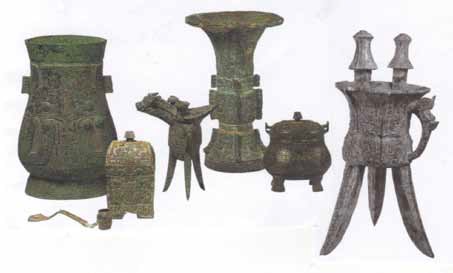
Before and during the Shang and Zhou Dynasties (21st century - 1045 BCE, and 1045 BCE - 221 BCE, respectively), the popularity of these beverages did increase. Many were long-fermented and consumed by ordinary folk at less than ordinary meals or special events, and/ or by priests as they honored the dead, attended to their burials, or performed other religious rites.
At many such events, different jiu drinks were found in storage or pouring containers. A few were in drinking cups set out with the deceased for use in their afterlife. Those who found and dated them were amazed at the number with liquid still in them.
By the last years of the Zhou Dynasty, Confucian protocols did discuss how these beverages and the foods found with them were made. This did help wine connoisseurship enrich the lives and knowledge of the living. Today, folk are amazed at how they influenced their industries.
By Han Dynasty times (206 BCE - 220 CE), poems and tales shared behaviors such as games played on drinking occasions if the beverages were distilled or not. There were white ones made with cereals, grapes, or other fruits, clear or dark ones made with still other items. A few reported swilling them appropriately a few told yet other tales of their consumption. Some told of having them with food, most only reported of guzzling them, and quickly.
Folks of the status of Lady Dai, whose remains are at Mawangdui in the Hunan Province from about the 2nd century BCE, have a little liquid in them, a few have a cup full or more. A few are two-eared drinking cups, others flasks or bowls for heating, storing, or pouring them. Some are ceramic a few are stone, and many are bronze or another metal, a few with ceramic edges to insure no poisoning from a metal.
By the Tang Dynasty (618 - 906 CE), there is much written about these beverages and what holds them, about the intoxication they can cause, and about general drinking behaviors. Alcoholic beverage use does increase daily as it does for special occasions such as festivals, sacrificial times, and many other times, too.
Some containers hold liquids from cereals raw, steamed, or cooked. Most are written about extensively as are their containers. Modern researchers note some are adulterated with sugar or diluted with water, some are clear, some of various colors, and they think some are to be used young, others when aged. Some were made with Sinkiang grapes, a few called ‘food for the Gods,’ and these are deemed popular.
According to historical records in Shinchi, by the time of the last Zhou Emperor infatuated with the beautiful Ta Chi, one finds ponds excavated and filled with yellow wine dedicated to her. Others have meat hanging from trees around these ‘Ponds of Wine and Forests of Meat’ that decorate places for things clearly sybaritic. Are their lives so licentiousness that they do not last long? Does drinking become a greater activity for common men? Tipplers know how to play the chiu-chuan guessing game, others select the sum of fingers game held out by its participants.
Grape wines are introduced to China from the west as is wine distillation. Some make kaoling (sorghum), providing pleasure as their alcohol content increases more during the Tang and Song Dynasties (618 - 907 CE and 960 - 1279 CE, respectively) when poets such as Li Bo gain reputations and inspirations drinking them.
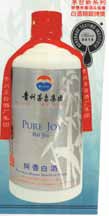
In these times, white ‘wines’ often have alcoholic content ranging upward from forty percent compared to wines nowadays measuring twelve to fourteen percent. A most famous one known as Bai Jiu, now more popularly called Mao Tai, is potent and made in the Guizhou Province from kaoliang. Others are made with glutinous rice and produced in or near Shanghai. One of lesser potency, a famous one from the Zhejiang Province, has an alcohol content of fourteen percent and is called Shao Xing wine.
The history of beer begins in the town of Qinghai at the German concession that has a brewery there. Bottled and spelled Tsingtao, it was and is made in the largest brewery in China. There are many other breweries making beer, probably more than a dozen. It is interesting to note that in China a bottle of beer costs about a quarter and billions of bottles do circulate at any one time. Though popular, most popular alcoholic beverages are still made with raw, cooked, or steamed rice, beers with sprouted hops, malts, and/or grains.
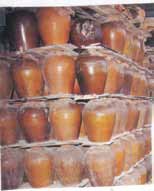
In rice wines, individual grains become liquid, and if there are any solids left, they are strained out and discarded or fed to local animals. Before doing so, they might be inoculated with mold or microorganisms from earlier batches and used in that way. They are often heated, incubated, cooled, and set aside, then strained, used or sold.
Years back, only young males could work with wines, had to face west, be clean, and not have sexual relations during wine-making seasons. Most wines were made with river water in Spring or Fall which are considered the best seasons to make wine.
Early oracle bone records of foods and regular and medicated wines were often reported on Chinese lunar calendars. Some were recorded on chop-sticklike items from the Shang Dynasty. They are the oldest such records in the world. These wines could act as solvents soaking up components from herbs or other items stored with them. Medicated ones were consumed to stimulate blood circulation, relax muscles and joints, and relieve rheumatic pain. Many are still in use along with newer ones designed and made more recently as health products.
The Chinese believe these beverages strengthen other medicines and/or help cure diseases. In the 1330 Principles of Correct Diet by the Turkic court therapist, Hu Si Hui, there is a discussion of many of them and some diet therapies known and used during his time. His thinking still influences folks in current generations. He knew and shared how to make them, take them, even develop new formulations to nourish the body and be tonics. Some were made with herbs and fruits added as are those seen in glass jars below. Many TCM practitioners speak about drinking medicated wines and eating seasonal foods during the Chinese Lunar months.
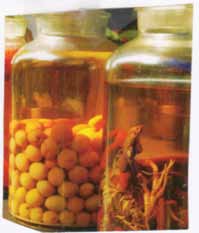
Early shamens did use mind-altering liquids to induce trances; many made with alcohol. Some can be traced to the Shen Nong period (circa 2000 - 1500 BCE) and the Chinese did make the oldest alcoholic beverages for improving health. We know from the preserved beverages unearthed at their excavations and from a few written items found with them, that they are earlier than Roman ones recovered from shipwrecks found in the Mediterranean Sea.
Some are found in ding, li, hu, zeng, xian, jiao, or other early containers, a few elsewhere. One researcher told us that drinking etiquette appears in writings of many archeologists telling people not to guzzle, and to wait to drink until elders finish theirs. One chap points out that in The Book of Rites, it shows a close relationship between wine and politics, and between government patterns of leaders and ordinary citizens. Jiu was and still is the main word the Chinese use for all alcoholic beverages whether from fermented grains such as millet, wheat, hops and other starches, or not fermented ones.
We did learn that alcoholic beverages made from cereals such as rice need sophisticated technology to convert their sugars, many use molds, malts, ferments, or mineral acids. Man’s saliva has an enzyme called ptyalin that can also do the job. Common people, tells us they drink these beverages more on holidays, festivals, and when entertaining than at other times.
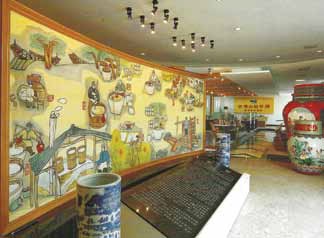
We did learn that Maotai, also known as the ‘Glory of China’ originated in the town of that name in Renhuai County in Guizhou Province and that it is stored about three years before going to market. Fengjiu is from the Apricot Flower Village in Fen Yang County in the Shanxi Province, Wuliangye is named for the five cereals used to make it including: rice and glutinous rice, sorghum, maize, and wheat. It comes from Yibin City in the south of the Sichuan Province; and that Luzhoulaojiaotequ is made in Luzhou City in the Sichuan Province.
Rice wines are very old Chinese alcoholic beverages, the most famous among them Shao Xing, is made in that city where there is a great wine museum. We did visit it when in there in Zhejiang Province many years ago. The picture of its most fascinating room; we share on this page. This wine is very popular in cooking, as a seasoning, and in many Chinese medicines.
One TCM practitioner said to tell readers that rice wine improves ones qi and blood circulation, maintains health, protects most organs, keeps skin healthy, warms and revitalizes the body, assists digestion, disinfects, is used in many decoctions, and mothers should use it daily post-partum for thirty days.
He went on to say that China makes potent liquors now called brandies, and he agrees that the most popular is Maotai, another Bamboo Leaf Liquor. It is sweet and often greenish-gold, with a long, history, written on ancient turtle shells, animal bones, and other/oracle bones, most ten times older than he is. He adds we should tell our readers that some add matrimony berries, ginseng, haw fruit, etc. while others include poisonous and non-poisonous snakes; other animals, too.
He continued that according to ancient historical records, there were eight things considered necessary for life including firewood, rice, oil, salt, liquor, sauce, vinegar, and tea. Liquor, he said was removed during the Yuan Dynasty (1279 - 1368) when rulers deemed it not needed daily, so only seven are now deemed necessary.
During the Shang Dynasty, he went on, many bronze containers were found to store ritual wines. Confucius did describe some of them, and some are on display at the Mawangduei site. He adds that Emperor Wudi (141 - 87 BCE)’ did send his first minister, Zhang Qian, to Afghanistan (circa 138 BCE) and that he did return with grapes and grape wine.
Many alcoholic beverage are components of Chinese social activities; and they have ferments using liquids and molds, some as indicated, found in empty buckets from rice or bread making. The Chinese believe most alcoholic beverages are warm or hot, beer is cold, and both can tenderize meat, remove fishy flavors, and can be added to many dishes to enhance their taste and texture.
While he also said most Chinese drink moderately, he admitted that some do so to excess, others just for health, and that people need not do so in excess. He also said to keep most refrigerated, and to use in soups, main courses, and desserts as the Fujianese do as it can be very healthy. He then said good-bye telling us that alcoholic beverage have different tastes, can and should be used to season foods, and that their medicated liquids are effective when used as prescribed, are health giving and popular, and we should try them. We promised to do so.
| Red Wine Lees |
|---|
1 pound long grain or glutinous rice
1. The day before planning to steam the rice, rinse it
several times, then soak it overnight with enough water
for two inches above the rice.
|
| Beef Brisket in Red Wine |
|---|
1½ pounds brisket of beef, blanched for two minutes, its water discarded
1. Put beef in large pot, add water to completely cover it
and add the spice bag, tangerine peel, and fresh ginger.
|
| Pork Belly in Wine |
|---|
1 pound pork belly with its skin left on
1. Slice pork belly into thin slices, and marinate in the
wine for one hour, then dry the slices well with paper
towels.
|
| Walnuts in Wine Sauce |
|---|
1/4 pound white and brown rock sugar, crushed
1. In a bowl, mix sugar, honey, and five ounces warm
water and stir until all the crushed sugar is dissolved.
|

Copyright © 1994-2025 by ISACC, all rights reserved
Address
3 Jefferson Ferry Drive
S. Setauket NY 11720